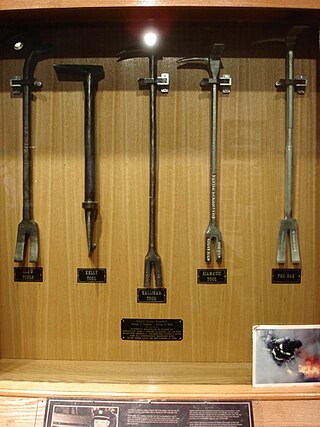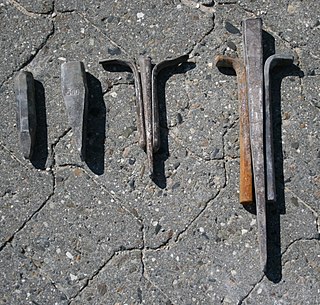
A forge is a type of hearth used for heating metals, or the workplace (smithy) where such a hearth is located. The forge is used by the smith to heat a piece of metal to a temperature at which it becomes easier to shape by forging, or to the point at which work hardening no longer occurs. The metal is transported to and from the forge using tongs, which are also used to hold the workpiece on the smithy's anvil while the smith works it with a hammer. Sometimes, such as when hardening steel or cooling the work so that it may be handled with bare hands, the workpiece is transported to the slack tub, which rapidly cools the workpiece in a large body of water. However, depending on the metal type, it may require an oil quench or a salt brine instead; many metals require more than plain water hardening. The slack tub also provides water to control the fire in the forge.

A chisel is a tool with a characteristically shaped cutting edge of blade on its end, for carving or cutting a hard material such as wood, stone, or metal by hand, struck with a mallet, or mechanical power. The handle and blade of some types of chisel are made of metal or of wood with a sharp edge in it.

A chainsaw is a portable gasoline-, electric-, or battery-powered saw that cuts with a set of teeth attached to a rotating chain driven along a guide bar. It is used in activities such as tree felling, limbing, bucking, pruning, cutting firebreaks in wildland fire suppression, and harvesting of firewood. Chainsaws with specially designed bar-and-chain combinations have been developed as tools for use in chainsaw art and chainsaw mills. Specialized chainsaws are used for cutting concrete during construction developments. Chainsaws are sometimes used for cutting ice; for example, ice sculpture and winter swimming in Finland.

A spade is a tool primarily for digging consisting of a long handle and blade, typically with the blade narrower and flatter than the common shovel. Early spades were made of riven wood or of animal bones. After the art of metalworking was developed, spades were made with sharper tips of metal. Before the introduction of metal spades manual labor was less efficient at moving earth, with picks being required to break up the soil in addition to a spade for moving the dirt. With a metal tip, a spade can both break and move the earth in most situations, increasing efficiency. A classic spade, with a narrow body and flat tip is suited for digging post holes, and is not to be confused with a "roundpoint" shovel, which has a wider body and tapered tip.

Drill bits are cutting tools used in a drill to remove material to create holes, almost always of circular cross-section. Drill bits come in many sizes and shapes and can create different kinds of holes in many different materials. In order to create holes drill bits are usually attached to a drill, which powers them to cut through the workpiece, typically by rotation. The drill will grasp the upper end of a bit called the shank in the chuck.

A Halligan bar is a forcible entry tool used by firefighters.

A mallet is a tool used for imparting force on another object, often made of rubber or sometimes wood, that is smaller than a maul or beetle, and usually has a relatively large head. The term is descriptive of the overall size and proportions of the tool, and not the materials it may be made of, though most mallets have striking faces that are softer than steel.

A kunai is a Japanese tool thought to be originally derived from the masonry trowel. The two widely recognized kinds are the short kunai and the big kunai. Although a basic tool, the kunai, in the hands of a martial arts expert, could be used as a multi-functional weapon. The kunai is commonly associated with the ninja, who used it to gouge holes in walls.
A reamer is a type of rotary cutting tool used in metalworking. Precision reamers are designed to enlarge the size of a previously formed hole by a small amount but with a high degree of accuracy to leave smooth sides. There are also non-precision reamers which are used for more basic enlargement of holes or for removing burrs. The process of enlarging the hole is called reaming. There are many different types of reamer and they may be designed for use as a hand tool or in a machine tool, such as a milling machine or drill press.
A crowbar is a tool with a curved end used for prying objects apart.

A pickaxe, pick-axe, or pick is a generally T-shaped hand tool used for prying. Its head is typically metal, attached perpendicularly to a longer handle, traditionally made of wood, occasionally metal, and increasingly fiberglass.

Cave digging is the practice of enlarging undiscovered cave openings to allow entry. Cave digging usually follows a search of mountains and valleys in karst topography for new caves. Often it takes place underground in places where a large passage has clearly been backfilled with silt, or choked with boulders. Sometimes chisels or explosives can be used to widen constrictions in the passage when spaces are evident on the other side.

A kitchen knife is any knife that is intended to be used in food preparation. While much of this work can be accomplished with a few general-purpose knives – notably a large chef's knife, a tough cleaver, a small paring knife and some sort of serrated blade – there are also many specialized knives that are designed for specific tasks. Kitchen knives can be made from several different materials.
This is a glossary of firefighting equipment.
A crowbar, also called a wrecking bar, pry bar or prybar, pinch-bar, or occasionally a prise bar or prisebar, colloquially gooseneck, or pig foot, or in Britain and Australia a jemmy or jimmy, is a lever consisting of a metal bar with a single curved end and flattened points, used to force two objects apart or gain mechanical advantage in lifting; often the curved end has a notch for removing nails.

Japanese carpentry was developed more than a millennium ago through Chinese architectural influences from the 12th century. It is a form of ancient Chinese wooden architecture and woodworking joints that involves building wooden furniture without the use of nails, screws, glue, or electric tools.

The Kelly tool is a tool used in fire and rescue service for forcible entry and other prying and striking tasks. The predecessor of the Halligan bar, it has largely been superseded by the latter, but still sees some use.

An axe is an implement that has been used for millennia to shape, split and cut wood, to harvest timber, as a weapon, and as a ceremonial or heraldic symbol. The axe has many forms and specialised uses but generally consists of an axe head with a handle, also called a haft or a helve.

The bark spud is an implement which is used to remove bark from felled timber.

Plug and feather, also known as plugs and wedges, feather and wedges, wedges and shims, pins and feathers and feather and tare, refers to a technique and a three-piece tool set used to split stone.


















